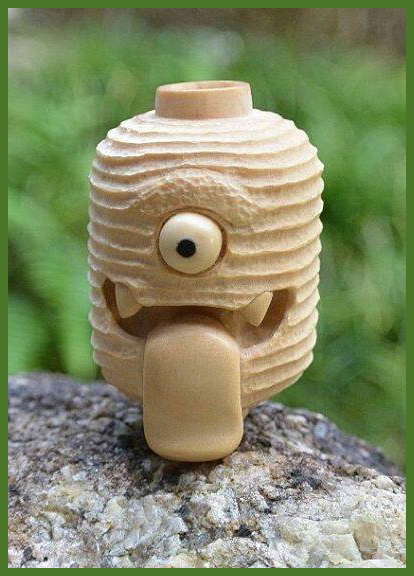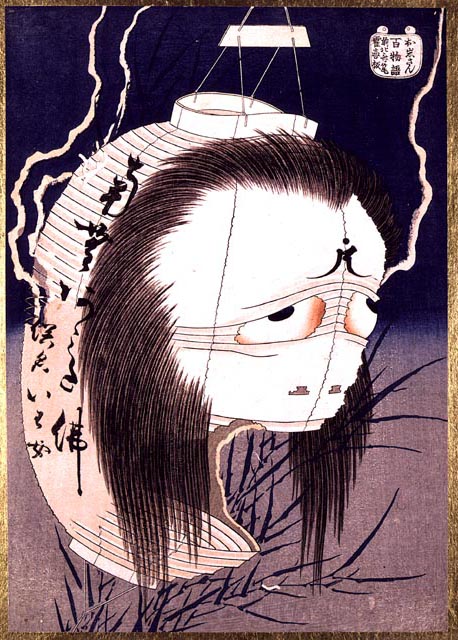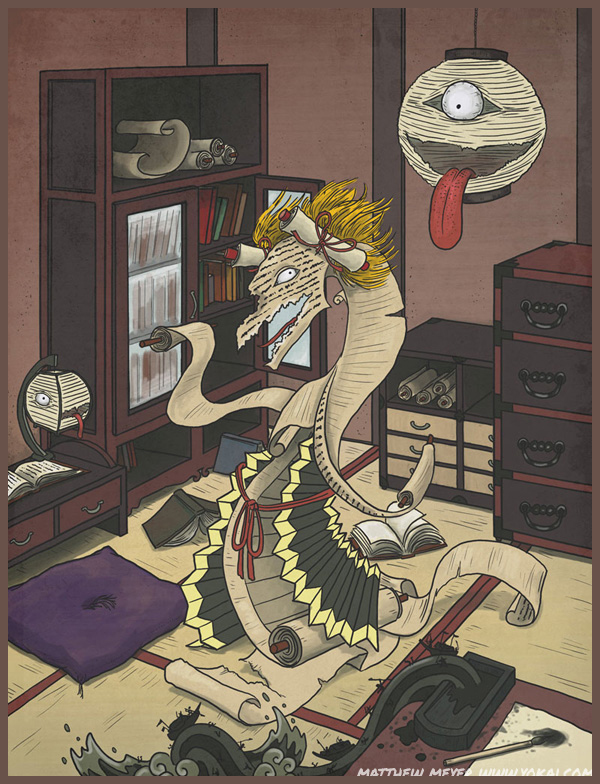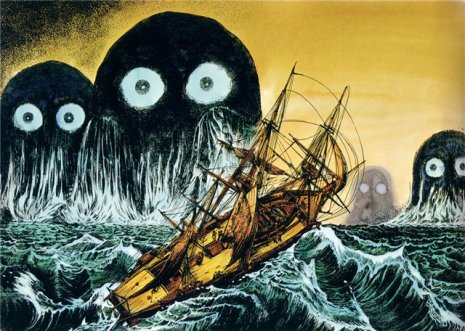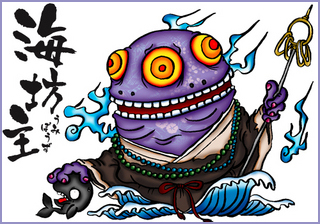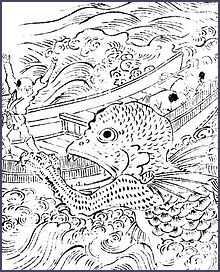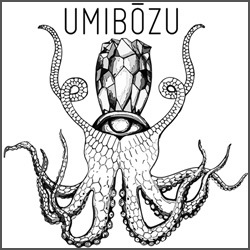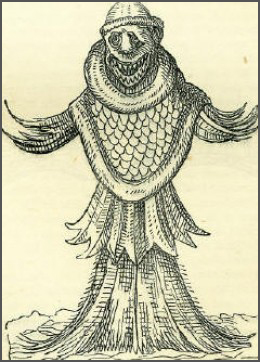- Yōkai 妖怪 Yokai monsters - - ABC-Index -
:::::::::::::::::::::::::::::::::::::::::::::::::::::::::::::::::::::::::::::::::::::::::::::::::::::::::::::::::::::::::::::::::::::::::::::::::::::::::::::::::::::::::::::::::::
Toriyama Sekien 鳥山石燕
(1712 – 1788)
an 18th-century scholar and ukiyo-e artist of Japanese folklore. He was the teacher of Utamaro and before taking up printmaking, a painter of the Kanō school.
Toriyama is most famous for his attempt to catalogue all species of yōkai in the Hyakki Yagyō series.
- source : wikipedia
. . . CLICK here for Photos of his monsters !
..............................................................................................................................................

Hokusai Manga
a pair of stone-swallows, which are fossilized shells in the shape of a bird.
In Japanese, they're called .... "Sekien!" (石燕)
- quoting Matt Alt -
..............................................................................................................................................
- - - - - Notable works - - - - -

The Illustrated Night Parade of A Hundred Demons (画図百鬼夜行, published in 1776)
Gazu Hyakki Yagyō (画図百鬼夜行, "The Illustrated Night Parade of a Hundred Demons") is the first book of Japanese artist Toriyama Sekien's famous Gazu Hyakki Yagyō e-hon series, published 1776. These books are supernatural bestiaries, collections of ghosts, spirits, spooks and monsters, many of which Toriyama based on literature, folklore, other artwork. These works have had a profound influence on subsequent yōkai imagery in Japan. (Also see: Hyakki Yagyō). The various creatures are described, below, using images to illustrate many of them.
- - - - -with illustrations of the demons
- source : wikipedia -
Toriyama Sekien Art Book
- and more reference at amazon com
- source : www.amazon.com/ -
. . . CLICK here for more Photos !
..............................................................................................................................................

The Illustrated One Hundred Demons from the Present and the Past (今昔画図続百鬼, published in 1779)
Konjaku Gazu Zoku Hyakki (今昔画図続百鬼, "The Illustrated One Hundred Demons from the Present and the Past") is the second book of Japanese artist Toriyama Sekien's famous Gazu Hyakki Yagyō series, published ca. 1779. These books are supernatural bestiaries, collections of ghosts, spirits, spooks, and monsters, many of which Toriyama based on literature, folklore, other artwork. These works have had a profound influence on subsequent yōkai imagery in Japan.
The three volumes were titled 雨, 晦, and 明.
- - - List of creatures
- source : wikipedia -
. . . CLICK here for more Photos !
.......................................................................

Supplement to The Hundred Demons from the Present and the Past (今昔百鬼拾遺, published in 1780)
Konjaku Hyakki Shūi (今昔百鬼拾遺, "Supplement to The Hundred Demons from the Present and the Past") is the third book of Japanese artist Toriyama Sekien's Gazu Hyakki Yagyō series, published ca. 1781. These books are supernatural bestiaries, collections of ghosts, spirits, spooks and monsters, many of which Toriyama based on literature, folklore, and other artwork. These works have had a profound influence on subsequent yōkai imagery in Japan.
- - - List of creatures
- source : wikipedia -
..............................................................................................................................................
The Illustrated Bag of One Hundred Random Demons (画図百鬼徒然袋, published in 1784)
Gazu Hyakki Tsurezure Bukuro (画図百器徒然袋, "The Illustrated Bag of One Hundred Random Demons") is the fourth book of Japanese artist Toriyama Sekien's famous Gazu Hyakki Yagyō series, published ca. 1781. These books are supernatural bestiaries, collections of ghosts, spirits, spooks and monsters, many of which Toriyama based on literature, folklore, other artwork. These works have had a profound influence on subsequent yōkai imagery in Japan.
- - - List of creatures
- source : wikipedia -
. . . CLICK here for more Photos !
:::::::::::::::::::::::::::::::::::::::::::::::::::::::::::::::::::::::::::::::::::::::::::::::::::::::::::::::::::::::::::::::::::::::::::::::::::::::::::::::::::::::::::::::::::

Japandemonium Illustrated:
The Yokai Encyclopedias of Toriyama Sekien
– November 16, 2016
by Toriyama Sekien (Author), Matt Alt (Editor, Translator), Hiroko Yoda (Editor, Translator)
Japanese folklore abounds with bizarre creatures collectively referred to as the yokai ― the ancestors of the monsters populating Japanese film, literature, manga, and anime. Artist Toriyama Sekien (1712–88) was the first to compile illustrated encyclopedias detailing the appearances and habits of these creepy-crawlies from myth and folklore. Ever since their debut over two centuries ago, the encyclopedias have inspired generations of Japanese artists. Japandemonium Illustrated represents the very first time they have ever been available in English.
This historically groundbreaking compilation includes complete translations of all four of Sekien's yokai masterworks: the 1776 Gazu Hyakki Yagyō (The Illustrated Demon Horde's Night Parade), the 1779 Konjaku Gazu Zoku Hyakki (The Illustrated Demon Horde from Past and Present, Continued), the 1781 Konjaku Hyakki Shū (More of the Demon Horde from Past and Present), and the 1784 Hyakki Tsurezure Bukuro (A Horde of Haunted Housewares).
The collection is complemented by a detailed introduction and helpful annotations for modern-day readers.
- source : www.amazon.com -
:::::::::::::::::::::::::::::::::::::::::::::::::::::::::::::::::::::::::::::::::::::::::::::::::::::::::::::::::::::::::::::::::::::::::::::::::::::::::::::::::::::::::::::::::::
. Tengupedia - 天狗ペディア - Tengu ABC-List .

.......................................................................
. - - - Join my Tengu friends on facebook ! - - - .
:::::::::::::::::::::::::::::::::::::::::::::::::::::::::::::::::::::::::::::::::::::::::::::::::::::::::::::::::::::::::::::::::::::::::::::::::::::::::::::::::::::::::::::::::::

. - - - Join my Kappa and Yokai friends on facebook ! - - - .

:::::::::::::::::::::::::::::::::::::::::::::::::::::::::::::::::::::::::::::::::::::::::::::::::::::::::::::::::::::::::::::::::::::::::::::::::::::::::::::::::::::::::::::::::::
. Onipedia - 鬼ペディア - Oni Demons - ABC-List - .

Oni in the direction "ushi tora" 丑寅 ox-tiger
at the kimon 鬼門 "demon gate"
So they are portrait with a tiger-skin loincloth and horns of a bull.
.......................................................................

金時と鬼の腕相撲 Kintoki and Demons Arm Wrestling
Nanajuunana oo Sekien giga 七十七翁石燕戯画
. Kintaro 金太郎 "The Golden Boy" Kintoki 金時 .
坂田金時 Sakata Kintoki
.......................................................................
. Gagoze - Gangōjil 元興時 Temple Gango-Ji . .
..............................................................................................................................................
Hyakki Yagyō, Hyakki Yakō 百鬼夜行 "Night Parade of One Hundred Demons"

- - - - - hyakki yagyoo emaki o yomu 百鬼夜行絵巻をよむ
田中貴子, 澁澤龍彦, 小松和彦, 花田清輝
- quote -
Hyakki Yagyō, variation: Hyakki Yakō, (百鬼夜行, "Night Parade of One Hundred Demons") is a concept in Japanese folklore. It is a parade which is composed of a hundred kinds of yōkai.
Legend has it
that "every year the yokai Nurarihyon, will lead all of the yōkai through the streets of Japan during summer nights." Anyone who comes across the procession would perish or be spirited away by the yōkai, unless protected by handwritten scrolls by anti-yokai onmyoji spellcasters. It is said that only an onmyoji clan head is strong enough to pass Nurarihyon's Hyakki Yagyo unharmed.
According to the account in the Shūgaishō (拾芥抄) Shugaisho,
a medieval Japanese encyclopedia, the only way to be kept safe from the night parade if it were to come by your house is to stay inside on the specific nights associated with the Chinese zodiac or to chant the magic spell:
"KA-TA-SHI-HA-YA, E-KA-SE-NI-KU-RI-NI, TA-ME-RU-SA-KE, TE-E-HI, A-SHI-E-HI, WA-RE-SHI-KO-NI-KE-RI"
(カタシハヤ, エカセニクリニ, タメルサケ, テエヒ, アシエヒ, ワレシコニケリ).
-- In literature
The hyakki yagyō has appeared in several tales collected by Japanese folklorists.
-- Uji shui Monogatari (宇治拾遺物語), in which a monk encounters a group of a hundred youkai which pass by the Ryūsenji temple.
-- Konjaku Monogatari Shuu (今昔物語集), which tells that during the Jougan Era (859–877), the eldest son of minister Fujiwara was on his way to his lover's place when he saw 100 demons walking from the direction of the University of Tokyo Miya main street. Since his attire had the sonjoushi written on it, the demons who noticed this ran away.
-- Ookagami (大鏡, Okagami) The Great Mirror
-- Goudanshou (江談抄) Godanshu
-- Kohonsetsuwashuu (古本説話集)
-- Houbutsushuu (宝物集) Hobutsushu
The night parade was a popular theme in Japanese visual art.
One of the oldest and most famous examples is the 16th-century handscroll Hyakki Yagyō Zu (百鬼夜行図), erroneously attributed to Tosa Mitsunobu, located in the Shinju-an of Daitoku-ji, Kyoto.
For other picture scrolls, the Hyakki Yagyō Emaki (百鬼夜行絵巻), contains the details of each member in the parade from the Muromachi period.
Other notable works in this motif include those by Toriyama Sekien (Gazu Hyakki Yagyō) and Utagawa Yoshiiku. However, Toriyama's work presents yokai in separate, encyclopedic entries rather than assembled in a parade, while Utagawa's Kokkei Wanisshi-ki ("Comical Record of Japanese History") employs the theme of 100 demons to comment on contemporary Japanese military actions in China.
- - - More in the WIKIPEDIA !

..............................................................................................................................................
- - - - - H A I K U - - - - -
古寺や百鬼夜行の霜のあと
furudera ya hyakki yagyoo no shimo no ato
this old temple -
remains of frost after the hundred demons
have passed at night
光起が百鬼夜行く野分哉
hikariki ga hyakki yoru yuku nowaki kana
. Masaoka Shiki 正岡子規 .

. oomagatoki, Ōmagatoki 逢魔時 / 大禍時 "demon dusk" .
..............................................................................................................................................
夜寒さや百鬼夜行の絵巻物
yosamusa ya hyakki yagyoo no emakimono
this cold night -
the picture scroll of hundred demons
passing at night
寺田寅彦 Terada Torahiko (1878 - 1935)
.......................................................................
曉齋の百鬼夜行図おお涼し
高澤良一
月の寺百鬼夜行図など蔵す
黒田杏子
花嫁に百鬼夜行のまんじゆしやげ
加藤かけい
虎落笛百鬼夜行を旨とせり
柴田奈美
雪折れは百鬼夜行の跡ならむ
松尾龍之介
すててこや百鬼夜行のしんがりの
佐々木六戈
:::::::::::::::::::::::::::::::::::::::::::::::::::::::::::::::::::::::::::::::::::::::::::::::::::::::::::::::::::::::::::::::::::::::::::::::::::::::::::::::::::::::::::::::::::
. Onipedia - 鬼ペディア - Oni Demons - ABC-List - .
. Tengu 天狗と伝説 Tengu legends "Long-nosed Goblin" .
. - yookai, yōkai 妖怪 Yokai monsters - .
. Legends and Tales from Japan 伝説 - Introduction .
. Mingei 民芸 Regional Folk Art from Japan .
- #toriamasekien #sekientoriyama #hyakkiyagyoo #hyakki -
:::::::::::::::::::::::::::::::::::::::::::::::::::::::::::::::::::::::::::::::::::::::::::::::::::::::::::::::::::::::::::::::::::::::::::::::::::::::::::::::::::::::::::::::::::
[ . BACK to DARUMA MUSEUM TOP . ]
[ . BACK to WORLDKIGO . TOP . ]
:::::::::::::::::::::::::::::::::::::::::::::::::::::::::::::::::::::::::::::::::::::::::::::::::::::::::::::::::::::::::::::::::::::::::::::::::::::::::::::::::::::::::::::::::::

